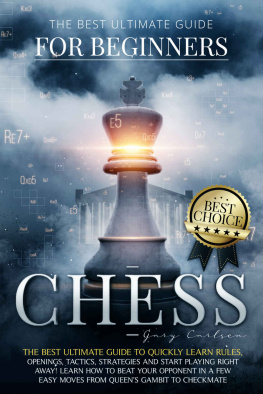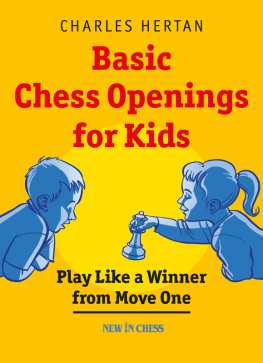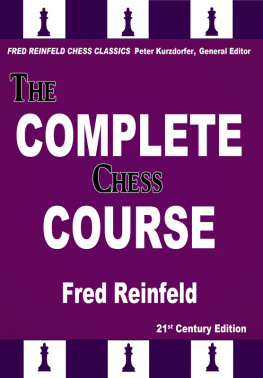The
Complete Chess Course
From Beginning
To
Winning Chess!
by
Fred Reinfeld
21st Century Edition
Fred Reinfeld Chess Classics
Peter Kurzdorfer, General Editor

2016
Russell Enterprises, Inc.
Milford, CT USA
The Complete Chess Course
From Beginning to Winning Chess!
Copyright 2016 Donald Reinfeld and Judith Reinfeld
Fred Reinfeld Chess Classics Peter Kurzdorfer, General Editor
ISBN: 978-1-941270-24-0
Ebook ISBN: 978-1-941270-25-7
All Rights Reserved
No part of this book may be used, reproduced, stored in a retrieval system or transmitted in any manner or form whatsoever or by any means, electronic, electrostatic, magnetic tape, photocopying, recording or otherwise, without the express written permission from the publisher except in the case of brief quotations embodied in critical articles or reviews.
Published by:
Russell Enterprises, Inc.
PO Box 3131
Milford, CT 06460 USA
http://www.russell-enterprises.com
The publisher and editor wish to express their thanks to David MacEnulty for his permission to use the explanation of English Algebraic Notation as set forth in his book My First Book of Chess Tactics.
Cover design by Janel Lowrance
Printed in the United States of America

From the Editor
Mid-20th century best-selling author Fred Reinfeld introduced thousands of players to the wonderful game of chess through his tireless efforts. His books were ubiquitous and covered every conceivable aspect of the royal game.
I was one of countless chess players representing several generations who grew up surrounded by Reinfeld books. We couldnt get enough of them! He not only taught us how to play the game well, but also implanted in us his enthusiastic passion for learning the game.
Freds books are peppered throughout with words and phrases in italics to emphasize ideas. Moves are punctuated with single, double, and even triple exclamation marks and question marks to span the entire spectrum of emotions the moves conjure up.
He had a way of reducing the most intricate, complicated combinations to their basic components. After Reinfeld explains a combination, it makes sense.
Thus I am pleased and honored to be a part of bringing back my old mentor to new generations of chess players. Russell Enterprises Inc. is engaged in a project of resurrecting the immortal Reinfeld classics, republishing them with the modern algebraic notation in place of the archaic English descriptive notation that was popular years ago to make them accessible to 21st century chess players.
This undertaking, begun under General Editor Bruce Alberston, has been passed on to me. So I get to reread these wonderful old books, change the notation in ChessBase, type up Freds snappy prose, and look out for potential errors.
The few analytical errors that crop up from time to time are easily checked with the monster chess engine Fritz, which Fred never had access to. In those far-off pre-computer days, you analyzed each and every position, including any variations you thought up, with nothing more than a board and pieces, using your knowledge of the pieces potential.
Thus the few errors are no reflection on the authors ability or knowledge at all. I have called attention to only the most egregious ones, indicated by an asterisk, and appearing on page 288. They certainly do not detract at all from the fresh charm he imparts on each and every position he looks at.
The Complete Chess Course in particular was originally brought out as a series of separate books that Fred later combined. The only part that is slightly out of date is his treatment of the openings, which are rather nave by modern standards; however, that should make no difference at the intermediate or even national master level, as I know all too well.
Absorb the material included in this volume and you will play chess at a fairly high level. Or read through it all and enjoy Freds masterful explanations; you will certainly be entranced by his enthusiasm for the intricate relationships the pieces experience in the context of a game or even a standout plan or combination.
The section on notation is the only portion of this work that Fred Reinfeld did not write. Since he used the old English descriptive notation exclusively, that section has been replaced with the gracious permission of David MacEnulty from his My First Book of Chess Tactics.
Peter Kurzdorfer
Olean, New York
October 2015
Introduction
Although seven of the eight sections of this book were originally published as separate volumes, they were written with their coordination as a complete chess course in mind. Conveniently prefaced now by a new summarized review of the basic elements of chess, the resulting comprehensive whole provides the instruction that any chessplayer needs to develop a respectable degree of skill.
The integrated progression of subjects is treated in the following order. A player who knows the elements but little more about chess may not need the introductory steps revealed in Book One, but he does need to be warned about the types of mistakes neglected development and the like that beginning and intermediate players make so frequently. He can then go on to study opening play in its larger aspects, and examine its consequences in the ensuing middlegame. From this point he proceeds to study the endgame stage, which evolves out of the middlegame previously studied. And finally, having seen the logical relationship which binds together opening, middlegame, and ending, the student is now ready to go back to the initial stage and study the chief openings in rewarding detail.
With this overall scheme in mind, the reader is in a better position to appreciate the detailed treatment in each section.
Book One is a summary of chess fundamentals that provides the first springboard into the royal game for beginners, and also serves as a refresher for the more advanced player.
Book Two is a study of the nine most common mistakes made by chessplayers. These include such typical errors as failing to guard against hostile captures, underestimating the opponents threats, and making pawn moves that weaken the castled position. Many examples are given to show how these and other mistakes prove disastrous in the opening and middlegame.
Now that the reader has been made aware of the kinds of mistakes he must avoid, he is ready to study the problem of planning the opening so as to get a promising middlegame position. First the subject is treated from Whites point of view (Book Three). Dealing with such problems as control of the center, how to exploit superior development and mobility, and the like. But it is at least equally important to deal with opening problems from Blacks point of view, and this brings us to Book Four; here problems of counterattack and defense are emphasized.
These studies of middlegame play lead logically to a treatment of the endgame stage, for whatever happens in the final part of the game is the consequence of what happened earlier in the opening and middlegame. As a rule, the chief practical problem of endgame play is how to win with a material advantage which has been obtained in the middlegame. In Book Five the different types of endings are classified and studied; many practical examples are explained, and the reader acquires an excellent grasp of the vital problem of converting a material advantage into victory.
Next page










